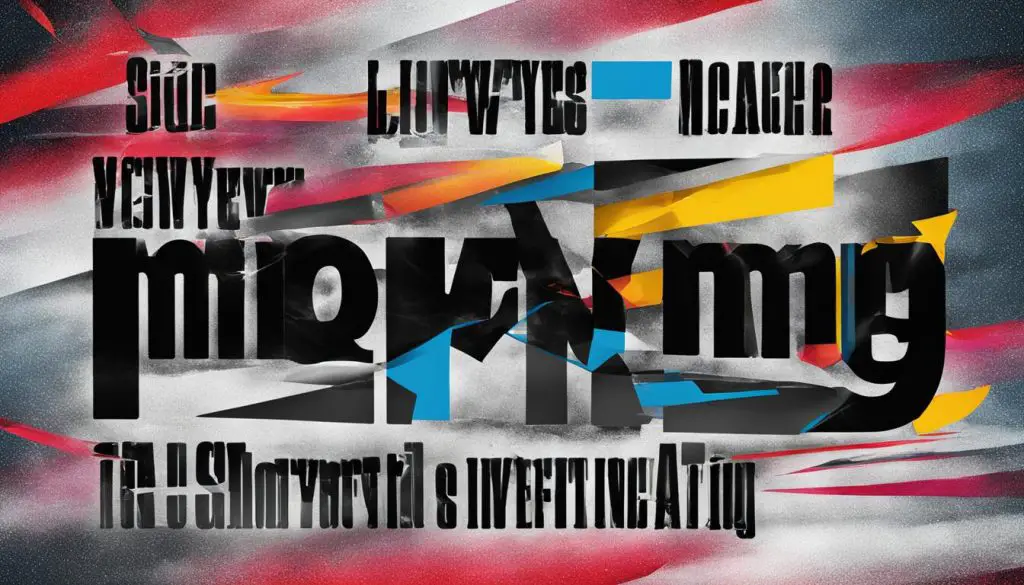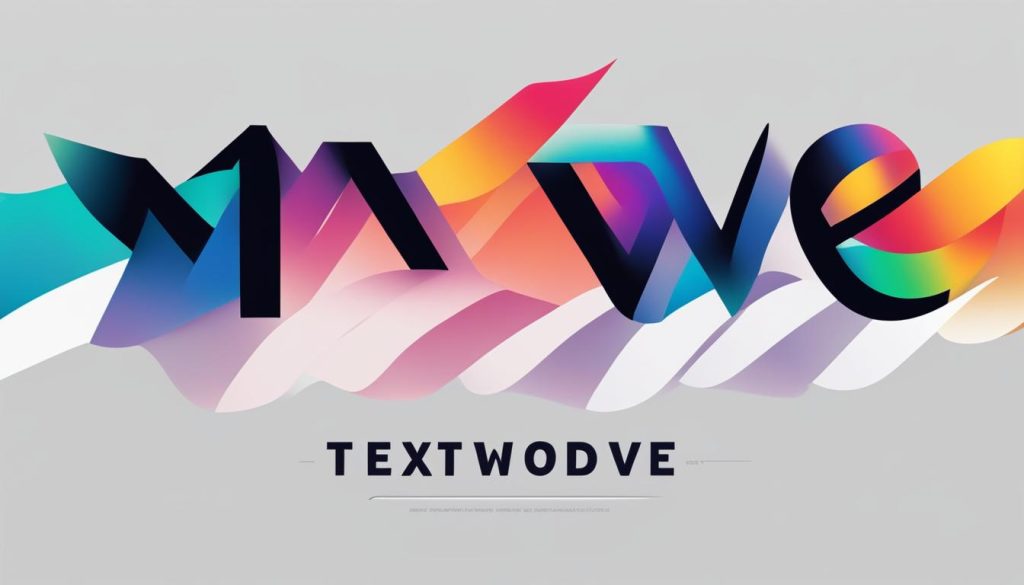GIMP is a powerful graphic design software that allows users to manipulate and move text layers with ease. With the right knowledge and skills, you can create stunning and dynamic designs by effectively arranging and positioning text in GIMP. In this comprehensive guide, we will explore various techniques and tools that will allow you to master the art of text movement in GIMP. From basic text manipulation to advanced text effects, this guide will provide you with detailed instructions and tips to enhance your graphic design projects.
Key Takeaways:
- GIMP offers powerful text movement capabilities for creating dynamic designs.
- Understanding typography fundamentals is essential for effective text manipulation in GIMP.
- Learn how to use GIMP’s text tool to precisely move, resize, and align text layers.
- Explore different text effects in GIMP to enhance the visual impact of your designs.
- Combine text and images in GIMP to create cohesive and impactful compositions.
Understanding Typography in GIMP
Typography is a fundamental aspect of graphic design that greatly influences the overall visual communication and impact of a design. In GIMP, mastering the art of text movement requires a solid understanding of typography principles. By effectively selecting typefaces, font styles, and ensuring readability, you can create compelling and visually captivating designs in GIMP.
When working with text in GIMP, one of the first considerations is choosing the right fonts. Different typefaces evoke different emotions and convey different messages. Serif fonts, such as Times New Roman, are often associated with tradition and formality, while sans-serif fonts like Arial are more modern and clean in appearance. Experimenting with different fonts and font combinations can help you achieve the desired visual effect for your design.
| Typography Tip | Example |
|---|---|
| Pair a bold font with a subtle one | Impact + Arial |
| Use contrasting fonts for emphasis | Roboto + Gotham |
| Combine a script font with a simple one | Great Vibes + Open Sans |
Font size is another crucial aspect of typography. It’s important to ensure that your text is legible and appropriately sized for the intended purpose. In GIMP, you can easily adjust the font size by selecting the text layer and using the scale tool to resize it. Keep in mind that font size should be proportional, with important information displayed in a larger font size and less critical text in a smaller size.
By gaining a deeper understanding of typography in GIMP, you’ll be equipped with the skills to create visually stunning designs. Whether it’s choosing the right fonts, adjusting font sizes, or understanding the impact of different font styles, typography plays a significant role in text movement and manipulation in GIMP.
Text Manipulation Techniques in GIMP
GIMP offers a range of powerful text manipulation techniques that allow you to precisely position and move text layers in your designs. Whether you need to relocate a text element or align multiple text layers, GIMP provides the tools you need to achieve professional-looking typography.
Basic Text Manipulation
To move a text layer in GIMP, simply select the “Move Tool” from the toolbox and click and drag the text to the desired position. You can also use the arrow keys on your keyboard for more precise movement. GIMP allows you to resize text layers by selecting the “Scale Tool” and dragging the handles or manually entering the desired dimensions in the options panel.

Advanced Text Manipulation
If you need to rotate or flip text in GIMP, you can use the “Transform Tool.” Simply select the text layer, click on the tool, and choose the desired transformation from the options panel. GIMP also offers alignment options to help you align text layers with precision. Use the “Align Tool” to align text horizontally or vertically, or use the “Align Layers” feature to align multiple text layers at once.
Additionally, GIMP allows you to group text layers together using layer groups. This can be useful when working with multiple text elements that need to be moved or manipulated together. To create a layer group, right-click on the layers you want to group, select “Group Layers,” and then you can move or manipulate the entire group as a single entity.
Summary
Mastering text manipulation techniques in GIMP is essential for creating visually appealing designs with precise text positioning. By utilizing the move, resize, rotate, and align tools in GIMP, you can achieve professional-looking typography in your graphic design projects. Experiment with these techniques and take advantage of GIMP’s text manipulation capabilities to elevate your designs to the next level.
Creating Text Effects in GIMP
GIMP offers a wide range of options and tools to create stunning text effects that can elevate the visual impact of your designs. Whether you want to add depth, dimension, or a unique style to your text, GIMP has got you covered. Let’s explore some of the exciting text effects you can achieve using this powerful graphic design software.
1. Adding Drop Shadows
One popular text effect that can instantly make your text stand out is the drop shadow effect. This effect creates the illusion of a light source casting a shadow behind the text, giving it depth and dimension. In GIMP, you can easily add a drop shadow to your text by accessing the “Layer” menu, selecting “Layer Style,” and choosing “Drop Shadow.” From there, you can customize the shadow’s color, size, opacity, and other parameters to achieve the desired effect.
2. Applying Gradients
Gradients can add a vibrant and dynamic look to your text. GIMP allows you to apply gradients to your text by selecting the “Text Tool,” typing out your desired text, and then accessing the “Blend” tool in the toolbox. From there, you can choose from a variety of gradient options and apply them to your text. Experiment with different gradient combinations to create eye-catching and unique effects.
3. Creating Outlines and Strokes
Adding outlines or strokes to your text can give it a bold and defined appearance. In GIMP, you can easily create outlines and strokes by selecting the “Text Tool,” typing out your desired text, and then accessing the “Stroke Path” option. From there, you can adjust the stroke’s color, size, and other properties to achieve the desired effect. Experiment with different stroke styles and colors to create striking text effects.
| Effect | Description |
|---|---|
| Drop Shadows | Adds depth and dimension to text by creating a shadow behind it. |
| Gradients | Applies a blend of colors to text, creating a vibrant and dynamic look. |
| Outlines and Strokes | Gives text a bold and defined appearance by adding outlines or strokes around it. |
By experimenting with these and other text effects in GIMP, you can unleash your creativity and take your designs to the next level. Remember to explore different combinations, adjust the settings, and let your imagination guide you. With GIMP’s powerful text capabilities, the possibilities are endless.
Combining Text and Images in GIMP
One of the strengths of GIMP is its ability to seamlessly integrate text with images, creating visually compelling compositions. By combining text and images in GIMP, you can create designs that effectively convey your message and capture the viewer’s attention. Whether you’re designing a poster, flyer, or social media graphic, understanding how to manipulate and position text in relation to images is crucial for creating cohesive and impactful designs.
When combining text and images in GIMP, there are several techniques you can use to achieve the desired effect. Placing text over images is a common approach that allows you to overlay text on top of an image, creating an eye-catching visual. To do this, you can use the text tool in GIMP to create a text layer and then position it over the image layer. You can adjust the size, font, color, and other attributes of the text to ensure it stands out against the background image.
Another technique for combining text and images in GIMP is adjusting the text’s opacity to make it blend into the background. By reducing the opacity of the text layer, you can create a subtle and harmonious integration of text and image. This technique works particularly well when you want the text to act as a supporting element to the image rather than taking center stage.
When combining text and images in GIMP, it’s important to consider the overall composition and visual hierarchy. The placement and size of the text should complement the image and guide the viewer’s attention. Experiment with different layouts and arrangements to find the most effective combination. Remember to also pay attention to the color contrast between the text and the image to ensure readability and legibility.
| Techniques for Combining Text and Images in GIMP | Benefits |
|---|---|
| Placing text over images | Creates a visually striking composition |
| Adjusting text opacity | Allows for subtle integration of text and image |
| Considering composition and visual hierarchy | Ensures a cohesive and balanced design |
By mastering the art of combining text and images in GIMP, you can elevate your designs and make them more engaging and effective. Experiment with different techniques and explore the possibilities that GIMP offers. Whether you’re designing for personal projects or clients, the ability to effectively combine text and images will be a valuable skill in your graphic design toolkit.

Additional Resources:
- GIMP Tutorials – Official GIMP tutorials for further learning
- GIMP Text Manipulation Videos – Video tutorials showcasing various text manipulation techniques in GIMP
- Typography Terms and Definitions – A comprehensive guide to typography terminology
Conclusion
Typography plays a vital role in graphic design, and mastering the art of text movement in GIMP can significantly enhance your design skills. Throughout this detailed guide, we have explored various techniques and tools that allow you to manipulate and move text layers in GIMP. By understanding the fundamentals of typography, learning text manipulation techniques, creating text effects, and combining text with images, you can create visually stunning designs that effectively communicate your message.
With GIMP’s powerful text editing capabilities, you can easily move text layers, adjust their size and orientation, and align multiple text elements in your design. By experimenting with different typography styles and effects, you can create unique and captivating visuals. Whether you want to make your text stand out with drop shadows or give it a three-dimensional look, GIMP offers a wide range of tools to bring your creative visions to life.
Remember, practice and experimentation are key to unlocking the full potential of GIMP’s text capabilities. Continuously explore and push the boundaries of what is possible with text movement in GIMP. With dedication and creativity, you can elevate your graphic design endeavors and create designs that leave a lasting impression.
